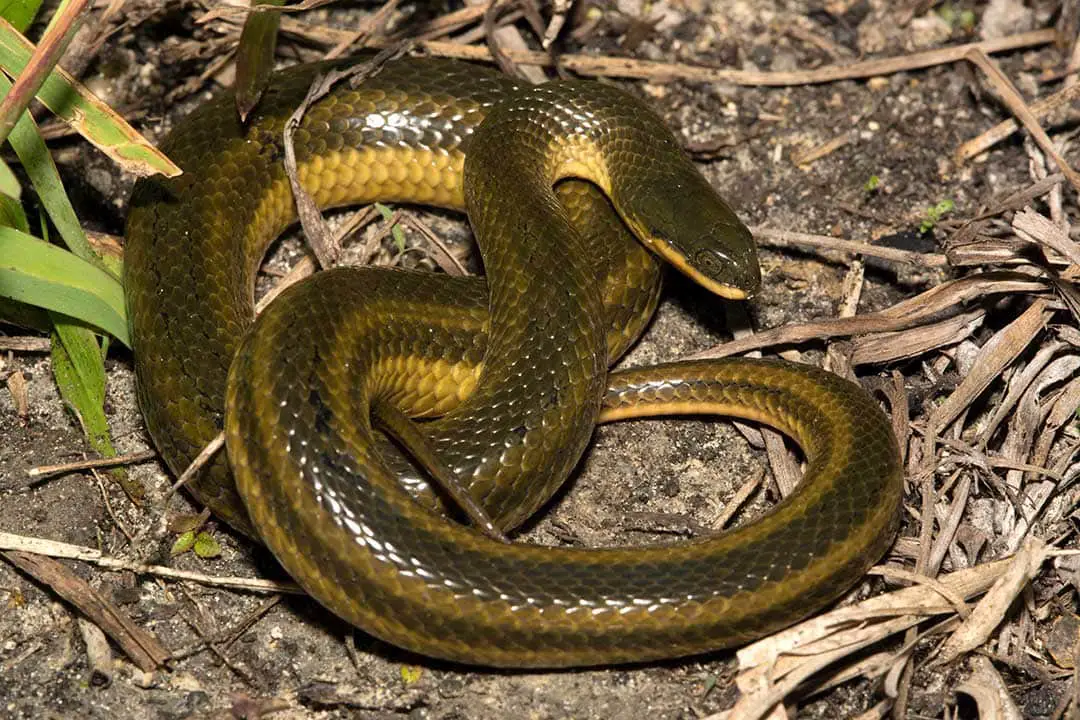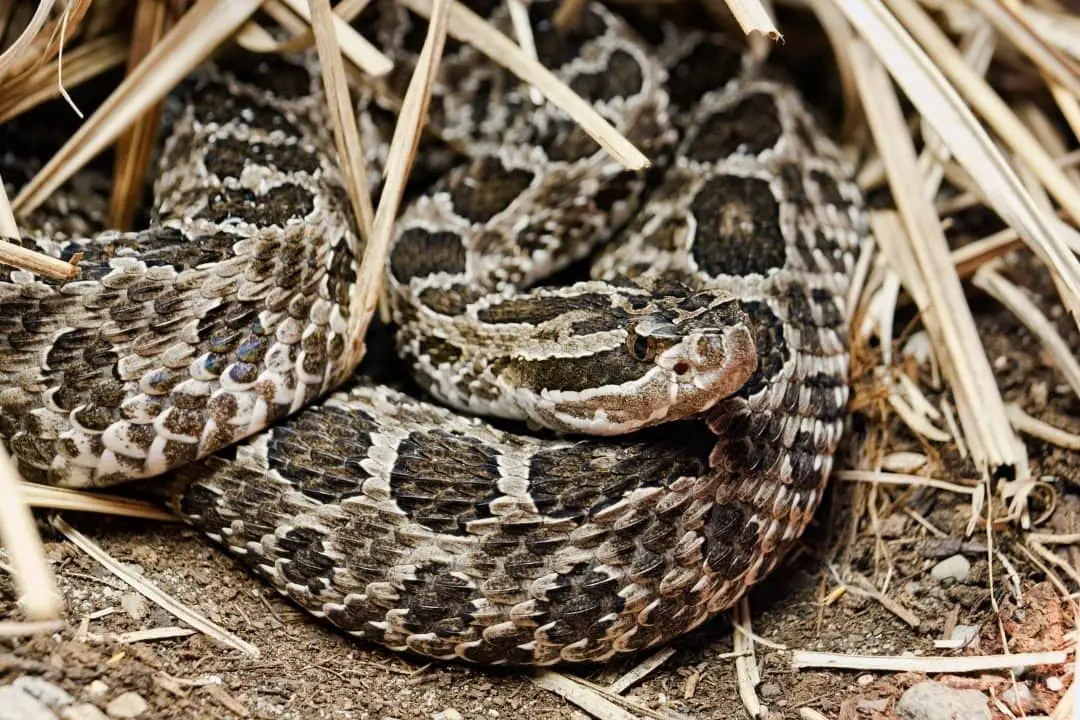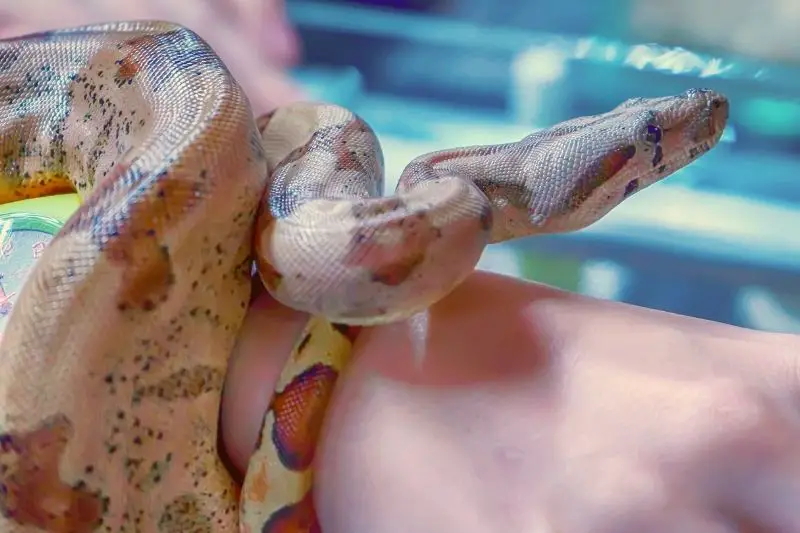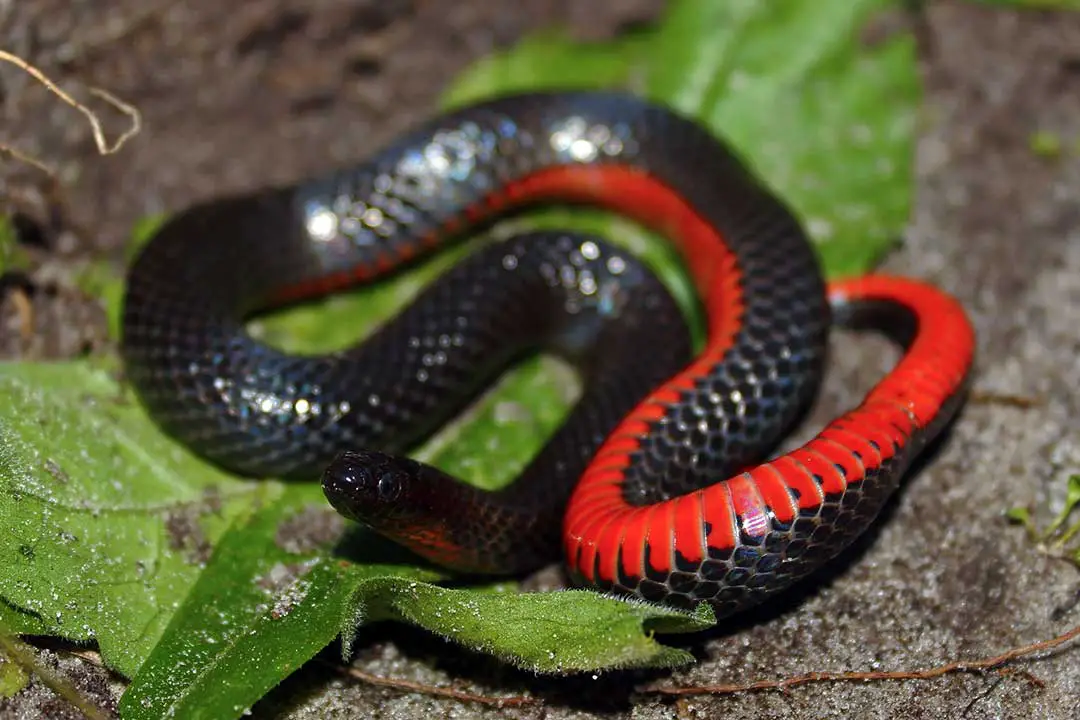Striped crayfish snakes are amazing snakes with a unique diet.
In this article, you’ll learn about the species. I’ll be covering what they are, how to identify the species, habitat, diet, and more. Read on to learn about these unique snakes.
Identification
Size
An adult striped crayfish snake is 13-20 inches (33-51 cm) long on average. The average mass for an adult Striped crayfish snake is only 1.5 ounces or 45.1 grams.
They have glossy scales. Females tend to be larger and have entirely smooth scales.
Males are smaller and have some ridged scales along the top of the tail and above the cloaca.
The largest female was 21 inches or 537 mm in snout-vent length and 27.7 inches or 705 mm in total length.
The largest recorded male was 19.9 inches or 507 mm snout-vent length and 23.8 inches or 606 mm in total length.
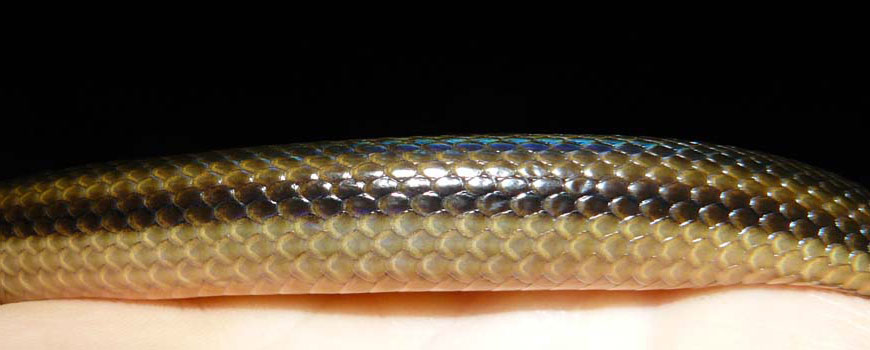
Color
They are brownish-yellow with three indistinct, dark stripes along the back and sides. The lower sides are yellowish-tan.
The belly is yellow to orange with a single row of spots going down the center. The head is small compared to the body and it has comparatively large eyes.
Juveniles are similar in appearance to adults aside from the size of the animal. A neonate striped crayfish snake will be about 133mm or 5.2 inches in snout-vent length.
They will weigh only 3.1 grams or 0.1 ounces.
Unique Teeth
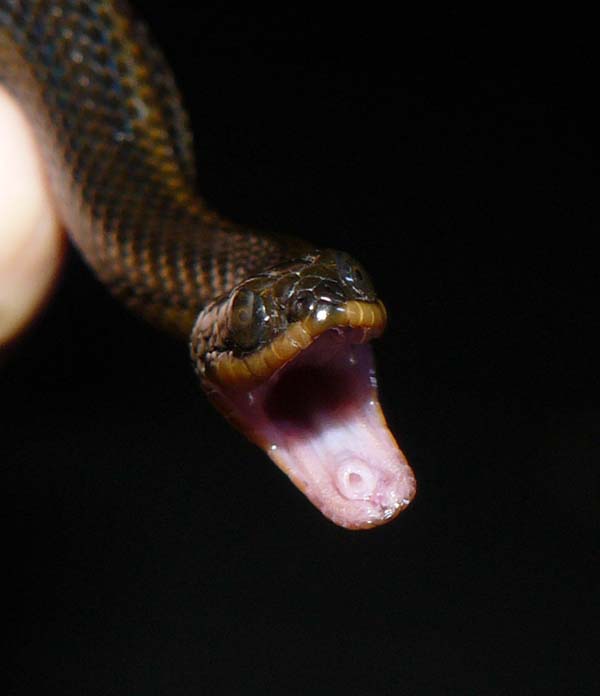
The teeth are unique in that they are specialized to grasp onto hard-shelled prey. The have hinged teeth located on the palatine bone.
These teeth are also shaped a bit like a chisel to help hold onto prey.
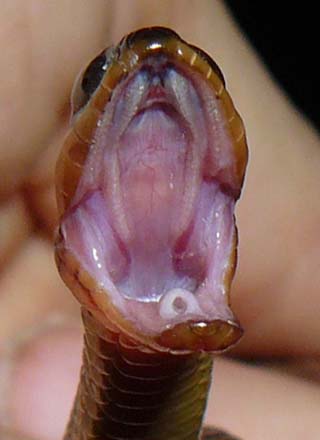
This makes it easy to identify skulls of the species since only the glossy crayfish snake (Liodytes rigida has similar teeth.
Behavior

All ages of striped crayfish snake rely on their coloration and habitat to help protect them from predators. They prefer to live in dense aquatic vegetation.
O’Brien (1998) described a striped crayfish snake attempting to avoid predation by a southern black racer (Coluber constrictor).
The striped crayfish snake wound itself tightly around vegetation to try to avoid predation. While this snake was not successful, it may work in other situations.
The striped swamp snake also has a few unique defensive behaviors.
When handled, these snakes will produce a foul-smelling musk from the cloaca and anal glands that can repel mammalian predators.
Godley (1982) described a unique defensive display. The animal gaped its mouth open, swayed, and arched its back.
Striped crayfish snakes that feel threatened will also ball up and hide the head under the body. They may also flatten the body laterally to appear larger.
While many snakes display similar behaviors, this can help identify the species taken with other traits.
They are similar in appearance to the glossy crayfish snake (Liodytes rigida rigida). The easiest way to tell them apart is to check the belly.
Glossy crayfish snakes have two rows of spots on the belly while striped crayfish snakes only have one.
Black swampsnakes (Liodytes pygaea can look similar from above to dark striped crayfish snakes.
However, they have a bright red to orange belly that is typically a solid color. This can be visible from the sides of the animal.
The diet can cause them to be mistaken for the Regina species, but the striped crayfish snake will eat crayfish at all stages of molt. Species like the queen snake also prefer different habitats.
Habitat and Distribution
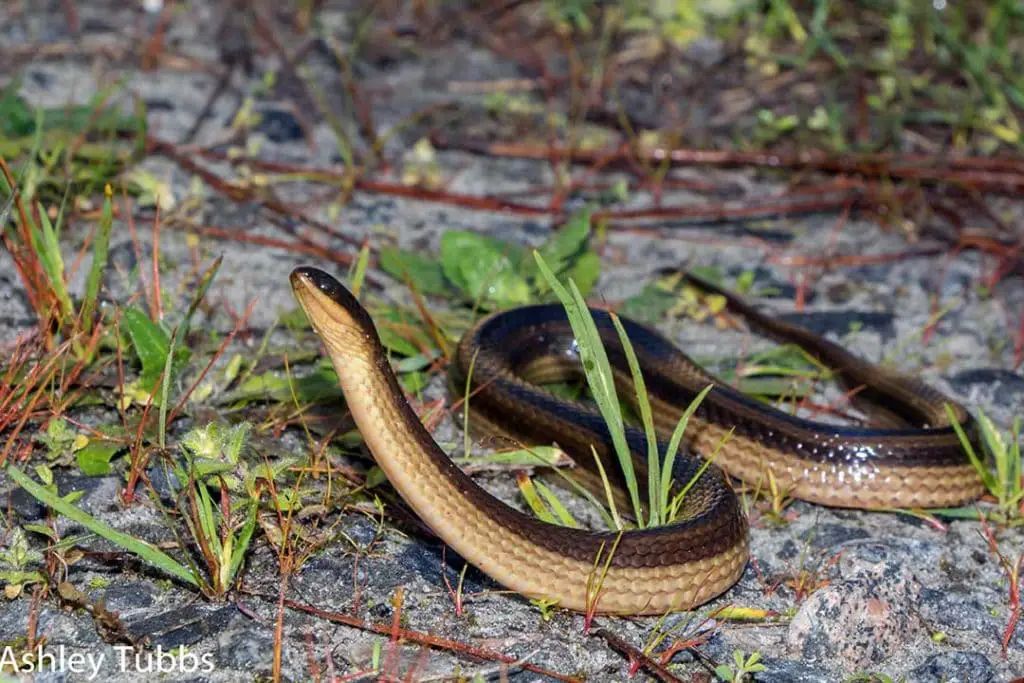
Striped crayfish snakes are native to Florida in central north america. The can be found over most of the peninsula and a small portion of the eastern panhandle.
They can also be found in a small portion of extreme southern Georgia close to the border with Florida. They are not found in the Florida Keys.
Striped crayfish snakes heavily prefer living in swamps and open wetlands with large amounts of vegetation.
Since their primary prey is crayfish, they will be found in areas with large amounts of prey, crayfish habitat.
They can also be found in saw grass prairies, cypress swamps, and even roadside ditches.
In Northern Florida, the species was very commonly found in patches of water hyacinth.
This study published in 1943 is an excellent example of what the population looked like almost 80 years ago.
They can still be found living and hunting among the roots of water hyacinth today. Striped crayfish snakes prefer still bodies of water and are rarely found in moving water such as streams.
Occasionally, they will be seen away from water. They have been found in crayfish burrows, under logs, and crossing roads during heavy rains.
It has been noted that the species is most common in waters with neutral pH and low dissolved calcium.
This causes the two species of crayfish they prefer to have softer exoskeletons.
They also prefer water hyacinth patches and will have the highest population densities in these patches.
The dense roots and floating portions of the plant provide protection from common predators.
The decaying plants commonly found in these patches also draw in and support large crayfish populations, providing a suitable habitat and pray crayfish supply.
Crayfish are primarily detritivores.
This means they eat rotting substances and are the “cleaners” of these ecosystems.
These dense patches also support populations of shrimp and dragonfly nymphs, the most common prey for juveniles snakes.
Diet
The primary diet of the striped crayfish snake is of course crayfish.
This semiaquatic north american snake has very sharp, specialized teeth that allow them to hang onto their hard shelled crayfish prey.
The striped swamp snake will hold the crayfish with the coils of their body while they eat the crayfish tail or abdomen first.
If they cannot find appropriate prey, they will take other prey types.
This is very common for juvenile snakes. They will also eat dragonfly larvae, other insect larvae, shrimp, salamanders, small frogs, and tadpoles.
Unlike other crayfish-eating snakes, they will typically not take pieces off of crayfish that are too large to eat.
They hunt at night since striped crayfish snakes are nocturnal.
They may also hunt at dawn or dusk. They spend the daylight hours basking on the surface on cool days and stay in the shade or underwater during hotter days.
They are also more active and feed more frequently during the spring and early summer.
They can eat very infrequently during the winter or may cease if it is too cold for them to safely digest their food.
Striped crayfish snakes rely on their sense of smell, sense of touch, and vision to hunt. According to several studies, they only strike moving crayfish.
They typically ignore crayfish on the bottom that are completely still. While they will use their tongue to help confirm that there is a crayfish, that is not how they line up to strike their prey.
They wait for movement to confirm location and then strike. They will bite down and loop at least one loop of the body around the crayfish to hold it.
This is typically on the carapace to help hold the crayfish and keep it from fighting back. Once the crayfish is secure, the snake will line it up to consume it.
Striped swamp snakes prefer the crayfish to be lateral relative to their skull and will eat starting at the tail or abdomen. This keeps the dangerous claws away from the snake’s sensitive head and eyes.
Consuming the crayfish this way also helps avoid internal injuries.
When consumed tail first, the legs and claws will all fold forward and be restrained until the crayfish dies.
Digestion can take over 24 hours. Recently molted crayfish will be digested faster than animals with a harder shell.
As such, these animals typically need longer periods to digest than species that eat soft-shelled crayfish or other types of prey.
Juveniles under 200 mm or 7.8 inches of snout-vent length will eat primarily small decapod crustraceans. Most of these will be shrimp in the family Palaemonidae.
All shrimp are eaten tail first regardless of size. Juvenile striped crayfish snakes over 7.8 inches will dragonfly nymphs.
However, the way the prey is eaten depends on the size of the prey compared to the snake. Smaller nymphs are eaten tail first. Larger nymphs will be eaten head first.
This study is a good overview of how crayfish-eating snakes like the striped crayfish snake consume their prey.
It goes over how the anatomy of the animal affects how it eats its prey and even what alternate food sources it will consume.
For instance, the striped crayfish snake will also consume the nymphs of dragonflies and damselflies.
This study published in 1980 documents the dietary shift of striped crayfish snakes (called Regina alleni at the time).
Snakes between 120-200mm (4.7-7.8 inches) in snout to vent length eat primarily dragonfly nymphs. They will also prey on shrimp and crayfish when they are seasonally available.
After this point, these snakes slowly replace the nymphs and shrimp with crayfish.
Another study from 2013 examines chemoreception of newborn striped crayfish snakes in response to their common prey.
It was shown they develop to sense nymphs only if that is what they eat.
Chemoreception is the response to chemical stimuli in the environment.
In the case of snakes, this refers to their sense of smell and information they gather from their tongues. Snakes use their forked tongue to gather the scent of their prey and track it down.
This study from 1977 studied feeding in captive snakes.
They recorded exactly how the snakes hunt and attack prey. It noted parasites and interesting avoidance behavior by the crayfish.
Crayfish species that are predated on by striped crayfish snakes will cease movement when they sense snakes.
The crayfish will also jump and rapidly swim away from the snakes. They only show this behavior in the presence of striped crayfish snakes.
Reproduction
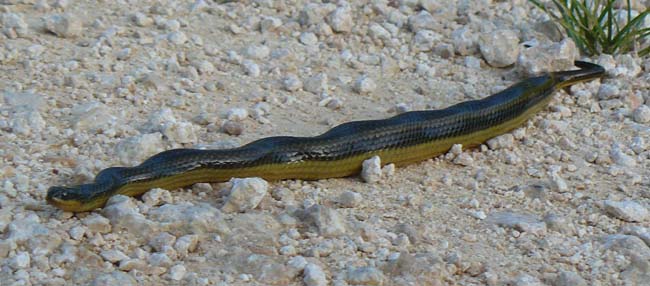
The reproduction of the striped crayfish snake is not well-known. It is theorized that the mating occurs sometime during spring. Females give birth to the live young during late summer or autumn.
The average litter size is 4-12. This depends on the size and health of the mother.
Larger snakes will produce a larger litter than smaller snakes. It is unknown exactly when these animals reach sexual maturity.
It could be in the second year when the animal reaches around 300mm in snout-vent length. This is also when the dietary shift occurs. The switch to its adult prey is likely when sexual maturity occurs.
It is also unknown how often these animals will breed. In most species of snakes, including closely related natricine snakes, all males will try to breed.
Females will only breed if they are healthy enough generally. An animal that hasn’t recovered enough from the previous year may not breed.
Further research is need to find out if this also holds true for striped crayfish snakes.
Since most other related species do not provide parental care, it is also unlikely that parent striped crayfish snakes care for their young after birth. It is also unknown how long this species will live.
With many species of snakes, you can at least generalize from captive animals. Whether the animal is kept as a pet by a breeder or is at a zoo, many species are only known from captive breeding behaviors.
This species is not particularly common as a pet or zoo animal. As such, there are also no notes on how long the species will live in captivity.
I have found limited claims of people keeping the species and managing to get them to breed, but there were no notes on lifespan or how it was managed.
Taxonomy
The scientific name for the striped crayfish snake is Liodytes alleni. They are in the kingdom Animalia, phylum Chordata, class Reptilia, order Squamata, suborder Serpentes, and family Colubridae.
They are also called allen’s snake, and striped swamp snake.
This means that they are vertebrate animals. They are reptiles in the colubrid family of snakes.
They are considered modern snakes in contrast to primitive snakes like pythons and boas.
They are also considered to be natricine snakes. They are most closely related to other snakes found near water like watersnakes, the Regina species, and garter snakes.
This study into the natricine snakes clarifies that crayfish eating has evolved at least 4 times. It is also a great primer on the relationships between garter snakes, watersnakes, and several species of crayfish-eating snakes.
This paper from 2003 (using the previous name of Regina alleni) has a good rundown of specifics like teeth, scalation, and anatomy that could be used to identify specimens of the species.
It also notes distribution including localities, the type locality, and fossil sites for the north american serpent species.
Conservation Status
Striped crayfish snakes are very abundant in water hyacinth patches.
They can also be found readily in any waterway that has relatively still water, plenty of vegetation, and a good population of crayfish. They are so abundant that you can find hundreds in an acre of water hyacinth.
As such, they are considered of least concern.
They do have a stable population over their whole range. In some areas, they are more abundant thanks to the spread of water hyacinth caused by humans.
They are somewhat less common in southern Florida thanks to habitat change. Many bodies of still water have been drained for development.
Some areas have also had significant changes to the flow of water or the chemistry of the water. Any area where crayfish populations are lowering will also have a lower amount of striped crayfish snakes.
There are rare occasions where wild snakes will be collected for the pet trade. This is not particularly common, but it does happen.
Since they have such a specialized diet, there is not much demand. This could change if feeder crayfish became commonly sold outside of their native range.
These snakes also need special enclosures that include land and plenty of water.
Like most other aquatic or semi-aquatic snakes, this makes them rare in captivity and not in demand for most keepers.
At the time of writing, these animals are not in danger of population loss due to the pet trade.
Frequently Asked Questions
These are a few common questions about the species. If you do not see your answer here, feel free to ask it in the comments below.
Conclusion
Striped crayfish snakes are wonderful animals that are endemic to Florida.
If you have been lucky enough to see a wild striped crayfish snake, we would love to hear about it in the comments below.
If you have any other questions or comments, please leave them below as well.
Photo credits: Andrew Dubois, Ashley Tubbs
